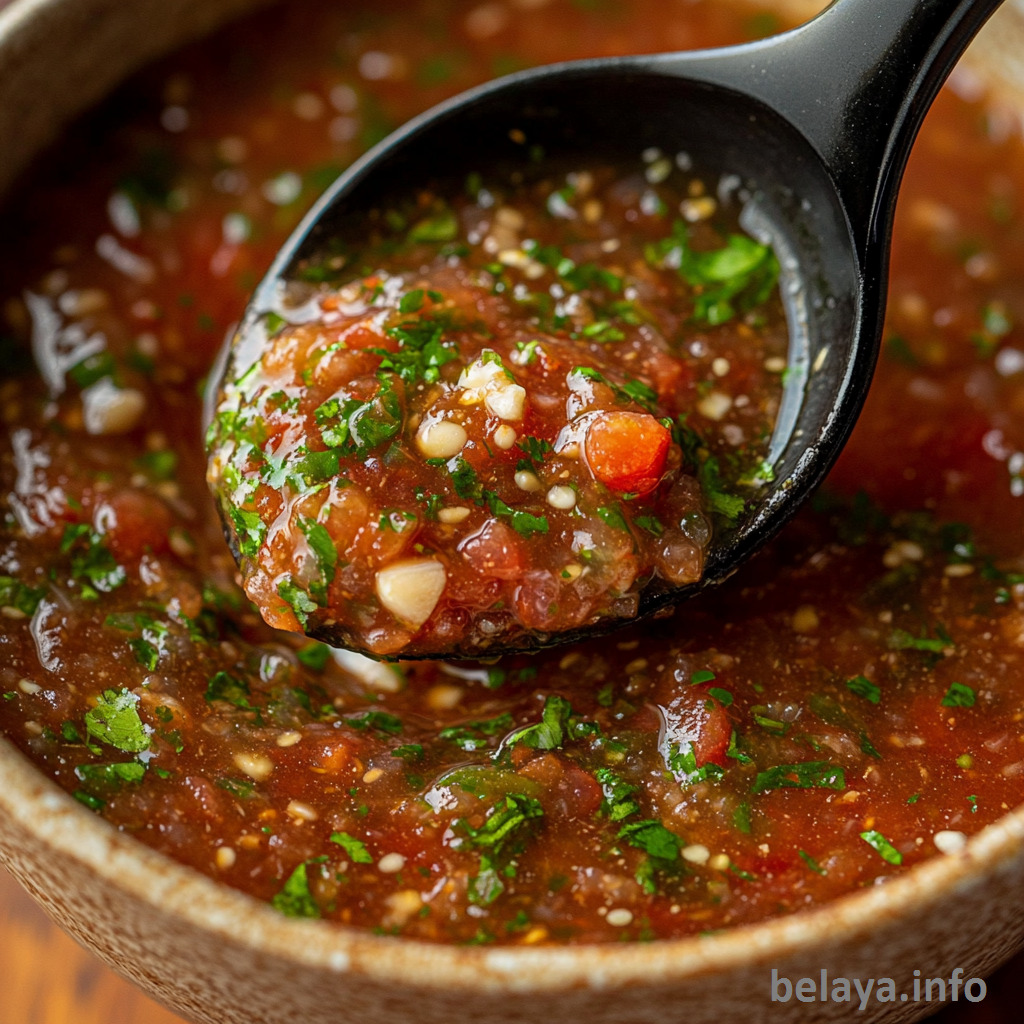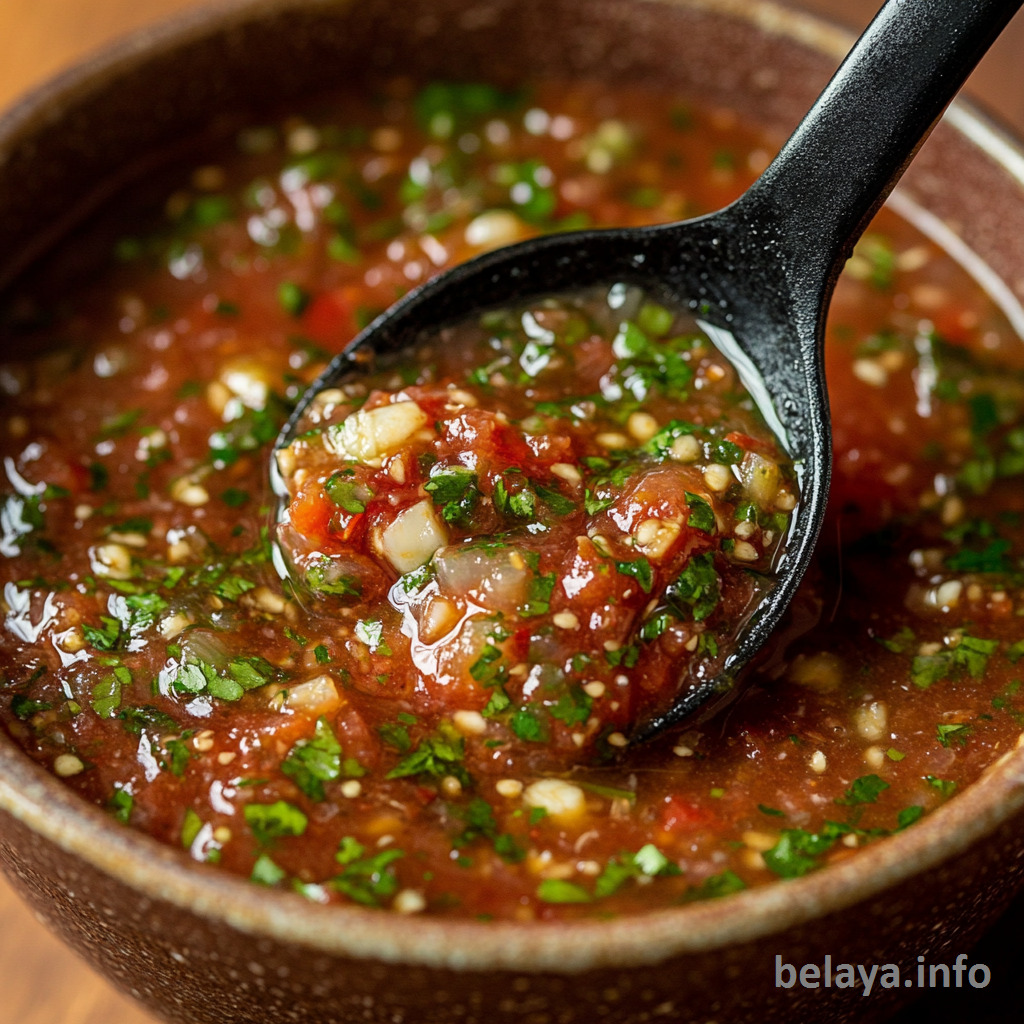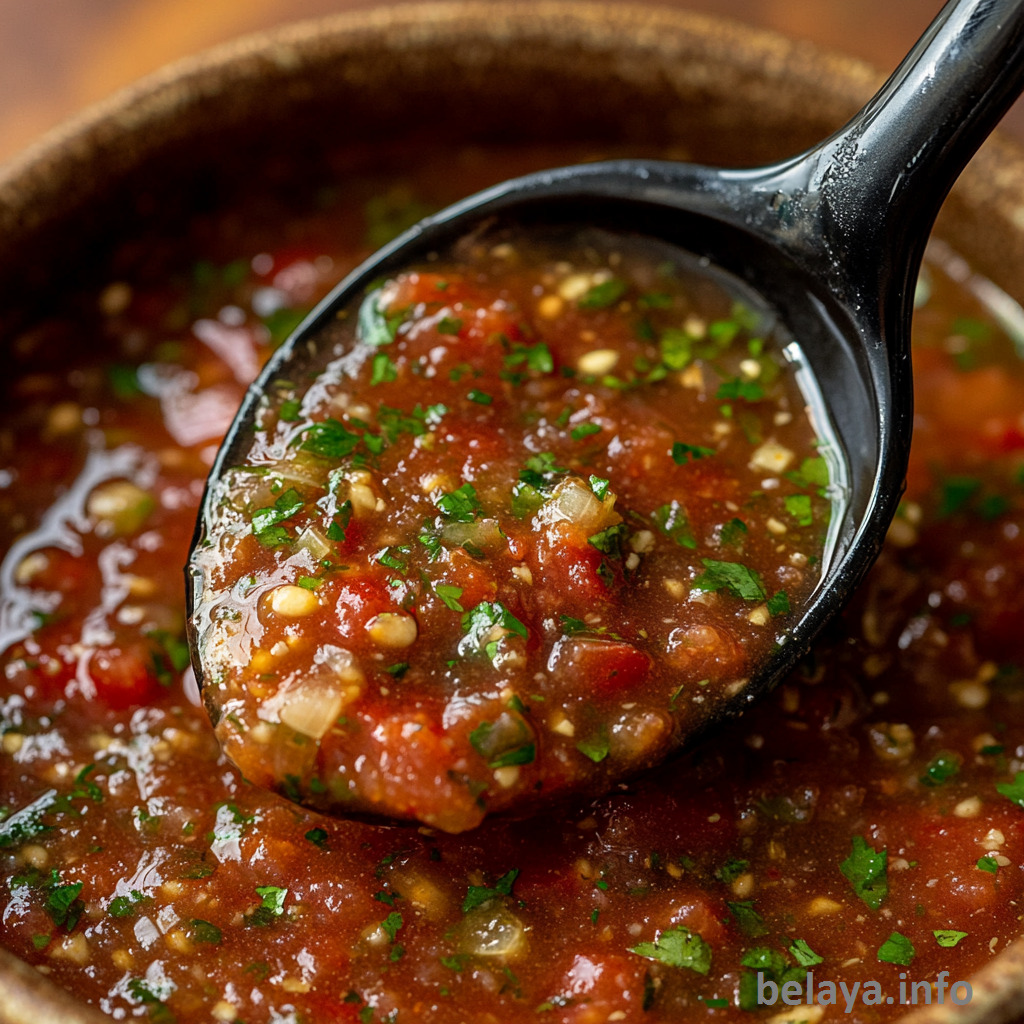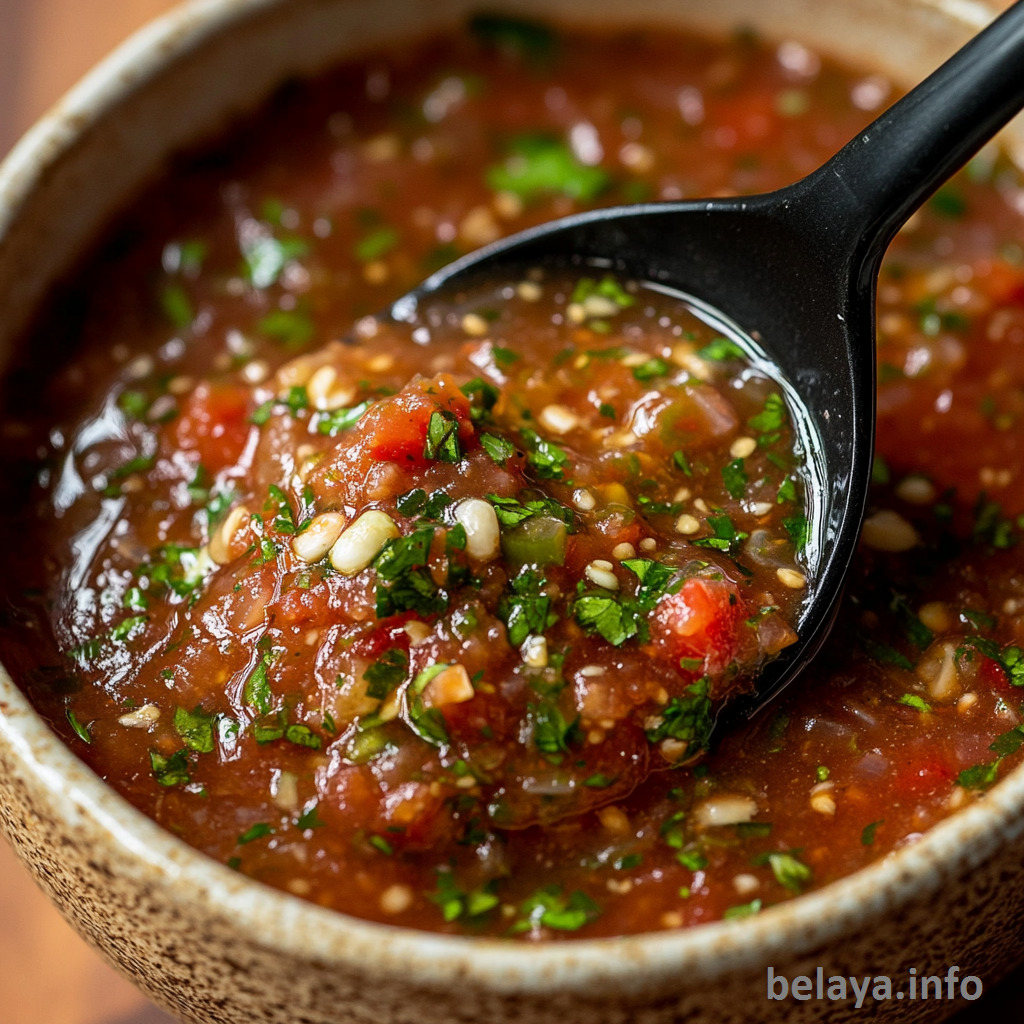Homemade Salsa Picante
There’s a certain magic in crafting your own salsa from scratch—especially when it’s a bold, smoky Salsa Picante like this one. Made with dried chipotle chiles and a vibrant mix of fresh tomatoes, chilies, and spices, this salsa offers a fiery depth that bottled versions simply can’t replicate.
The chipotles bring a rich, smoldering heat, while the vinegar and lime add brightness and tang. Each spoonful carries layers of complexity—earthy, smoky, spicy, and tangy—making it perfect for everything from tacos and grilled meats to breakfast eggs or a bowl of tortilla chips.
Once you taste the difference, this will become a staple in your kitchen.

Why People Will Love This Homemade Salsa Picante:
Rich, smoky depth of flavor: The use of dried chipotle chiles creates a distinctive smoky heat that adds complexity and character—something you can’t get from store-bought salsa.
Customizable spice level: With a mix of jalapeños, serranos, and cayenne, the heat level is easily adjustable to suit any preference—from mildly warm to fiery hot.
Fresh, natural ingredients: This recipe uses whole, real foods—no preservatives or artificial flavorings—making it healthier and more vibrant in taste.
Perfect for a wide variety of dishes: Whether served with tacos, grilled meats, burritos, scrambled eggs, or simply chips, this salsa elevates any dish with bold flavor.
Great for make-ahead and storage: It keeps well in sterilized jars, making it ideal for meal prep or gifting. A homemade condiment that’s always ready to enhance a meal.
Bright acidity and balance: The cider vinegar and fresh lime juice cut through the richness of the peppers, creating a balanced salsa that’s tangy, spicy, and addictive.
Satisfying and rewarding to make: There’s something deeply fulfilling about building flavor from the ground up and mastering a staple that’s often taken for granted.

Key Ingredients:
Dried chipotle chiles are the heart of this salsa, infusing it with a deep, smoky essence and a slow-building heat that lingers on the palate. Their complexity adds both flavor and depth unmatched by fresh chilies alone.
Fresh tomatoes provide a juicy, vibrant base that balances the heat with natural sweetness and acidity. They bring body, brightness, and a garden-fresh flavor that forms the salsa’s foundation.
Mixed chili peppers like jalapeños and serranos introduce layers of heat and green, grassy notes, enhancing both the punch and freshness of the sauce. Their diversity lets you tailor the spice profile.
Garlic and onion act as aromatic anchors, adding savory richness and umami depth. When blended, they fuse into the base to amplify the overall character of the salsa.
Apple cider vinegar and lime juice bring sharp, acidic brightness that cuts through the richness and smokiness of the chilies, preserving the salsa and giving it a crave-worthy tang.
Cilantro provides a fresh, herbaceous lift that contrasts the bold flavors, making each bite more lively and layered.

Expert Tips:
Toast the dried chipotle chiles before soaking: Lightly toasting them in a dry skillet for 30–60 seconds per side enhances their smokiness and releases essential oils, deepening the overall flavor of the salsa.
Use fire-roasted tomatoes for extra depth: Replacing raw tomatoes with fire-roasted canned or grilled tomatoes adds subtle char and umami, complementing the smoky chipotles beautifully.
Blend in stages for texture control: Start by pulsing the solid ingredients (onion, garlic, chilies, tomatoes) before adding liquids. This gives you more control over the final consistency—chunky or smooth, depending on your preference.
Let the salsa rest overnight: After simmering, allow the salsa to cool and sit in the fridge for 12–24 hours. This resting time lets the flavors meld and intensify, often making it taste better the next day.
Balance the heat with acidity and salt: Spicy salsas need bright acidity and proper salting to be balanced. Don’t be afraid to taste and adjust lime juice, vinegar, and salt toward the end.
Use filtered water if storing long-term: If you’re canning or jarring the salsa, using filtered or boiled water can help improve shelf life and clarity, preventing any off flavors from tap minerals.
Sterilize jars properly for safe storage: If storing the salsa for later use, always sterilize your jars in boiling water for at least 10 minutes and ensure the lids seal properly to avoid spoilage.
Add a splash of oil for richness (optional): A small amount of olive oil blended in can create a silky mouthfeel and help carry fat-soluble flavor compounds, especially if you’re using it as a cooking base or marinade.

Homemade Salsa Picante
Ingredients
10 dried chipotle chiles
2 cups fresh chopped tomatoes
2 cups assorted chopped chili peppers (jalapeños, serranos, or a spicy mix)
1 small onion, diced
4 to 5 cloves of garlic, minced
3 tablespoons chopped fresh cilantro
1 tablespoon ground cayenne pepper
1 teaspoon cumin powder
½ cup water
Sea salt and freshly ground black pepper, to taste
⅔ cup apple cider vinegar
Juice of 1 small lime
Instructions
Place the dried chipotle peppers in a small saucepan and cover with water. Bring to a boil, then take off the heat. Let them soak for about 20 minutes until softened.
Once softened, discard the stems, roughly chop the peppers, and transfer them to a food processor.
Add the chopped tomatoes, mixed chilies (like jalapeños and serranos), onion, and garlic to the processor. Pulse until coarsely blended.
Add cilantro, cayenne powder, cumin, water, cider vinegar, lime juice, and season with salt and pepper. Blend until the mixture becomes smooth.
Pour the salsa into a large saucepan. Bring it to a boil over medium-high heat, then lower the heat and simmer for 15 minutes.
Let the salsa cool slightly. Transfer to sterilized jars for storage, or serve immediately.

Important Notes When Making Homemade Salsa Picante:
Chipotle chiles define the flavor profile: These dried, smoked jalapeños are what give the salsa its signature smoky, earthy backbone. Their flavor is intense, so soaking and blending them well is key to a smooth, rich finish.
Ingredient ratios matter: The balance between tomatoes, chili peppers, acid (vinegar + lime), and spices creates harmony. Too much vinegar can overpower the natural sweetness of tomatoes; too little can leave the salsa flat or overly spicy.
Simmering is essential: Cooking the blended salsa for 15 minutes not only helps it thicken and develop flavor, but also stabilizes the mixture for longer shelf life if storing. Raw-blended salsas can taste harsh or unbalanced without this step.
Cayenne adds sharp heat—not smokiness: While chipotles bring slow, smoky warmth, cayenne adds a more direct, sharp spiciness. Use it to fine-tune the heat level, but don’t let it overpower the nuanced flavors.
Fresh lime juice brightens everything: Lime juice lifts the salsa, cutting through the richness and enhancing all the other elements. It’s best added after blending to preserve its fresh, citrusy punch.
Texture can be adjusted to preference: If you prefer a chunkier salsa, pulse the ingredients briefly instead of puréeing completely. For a smoother, sauce-like consistency (perfect for pouring or marinating), blend thoroughly and strain if desired.
Storage affects flavor: Like many sauces, the salsa picante tastes better after a day in the fridge. Flavors continue to blend and mellow, resulting in a deeper, more cohesive taste.
Salt levels change over time: Always taste the salsa after it cools. Heat and acid can dull salt perception during cooking, so final seasoning should be adjusted when it’s cool or just before serving.

How to Enjoy Homemade Salsa Picante After Cooking
Let It Rest for Peak Flavor
After simmering, allow the salsa to cool to room temperature, then refrigerate for a few hours or overnight. This resting period helps the flavors deepen and meld—resulting in a richer, more balanced taste.
Cold salsa also offers a refreshing contrast when served with hot dishes.
Serve as a Versatile Condiment
With tortilla chips – The classic way. Serve in a shallow bowl with warm, salted tortilla chips for dipping.
On tacos and burritos – Drizzle over carne asada, grilled chicken, or bean burritos for a spicy punch.
Over eggs – Add a spoonful over scrambled eggs, huevos rancheros, or breakfast tacos for a smoky wake-up call.
With grilled meats – Serve alongside steak, chicken, or pork as a spicy, zesty finishing sauce.
In rice bowls – Mix into rice and beans or drizzle over a burrito bowl to boost flavor.
Use as a Cooking Ingredient
Marinade base – Combine with olive oil and citrus juice for a flavorful marinade for beef, chicken, or tofu.
Simmering sauce – Add a few spoonfuls to sautéed veggies, chili, or stews to enhance depth.
Soup enhancer – Stir into tomato-based soups or black bean soup for a layered heat and smokiness.
Pair with the Right Foods and Drinks
Pairings: Try it with grilled corn, quesadillas, tamales, or empanadas for regional harmony.
Drinks: Cold beer, horchata, or a tangy margarita complement the bold flavors and heat of the salsa.
Presentation Tips
Garnish the salsa with a sprig of cilantro, a slice of lime, or crumbled queso fresco for a touch of color and elegance.
Serve in a small stone molcajete or rustic bowl to elevate the dining experience visually.

Nutrition Information
For one 2-tablespoon (30g) serving of Homemade Salsa Picante, presented in the format you requested:
Calories: 22 kcal | Total Fat: 0.9 g | Saturated Fat: 0.1 g | Monounsaturated Fat: 0.2 g | Polyunsaturated Fat: 0.3 g | Cholesterol: 0 mg | Sodium: 120–180 mg (depending on added salt) | Total Carbohydrates: 4.2 g | Dietary Fiber: 1.1 g | Sugars: 2.2 g | Protein: 0.8 g
Note: Nutrition values may vary slightly depending on the specific types and quantities of chilies, tomatoes, and vinegar used. This estimate assumes no added oil and moderate salt.

Frequently Asked Questions:
1. Can I use fresh chipotle peppers instead of dried?
Chipotle peppers are smoked and dried jalapeños, and their flavor is deeply tied to the drying and smoking process. Fresh chipotles are not typically available. If you can’t find dried chipotles, use canned chipotles in adobo sauce as a substitute—but reduce the vinegar slightly, as the adobo already contains acidity.
How spicy is this salsa, and how can I adjust the heat?
This salsa has medium to high heat due to chipotles, jalapeños, serranos, and cayenne. To lower the heat, reduce or omit the serranos and cayenne, and remove seeds from all chilies. To increase heat, add more serranos or use spicier varieties like habaneros.
How long does this salsa last, and how should I store it?
When stored in sterilized jars and refrigerated, this salsa lasts up to 2 weeks. For longer shelf life, it can be water-bath canned following proper canning procedures. Always refrigerate after opening.
Can I freeze Homemade Salsa Picante?
Yes, this salsa freezes well. Let it cool completely, pour into freezer-safe containers or bags (leaving room for expansion), and freeze for up to 3 months. Thaw in the refrigerator and stir before serving.
What can I serve this salsa with beyond chips and tacos?
It’s incredibly versatile—try it on scrambled eggs, grilled chicken, roasted vegetables, burgers, or mixed into soups and stews for added heat and smokiness. It also works as a marinade or dipping sauce for empanadas and quesadillas.
Why do I need to soak the dried chipotle peppers before blending?
Soaking softens the tough, leathery texture of dried chipotles and helps release their deep smoky flavor. Without soaking, they won’t blend smoothly and may result in a gritty salsa. A 20-minute soak in hot water is ideal for full rehydration.
Can I skip the simmering step after blending?
Simmering is important—it helps meld the flavors, thicken the texture, and extend shelf life by reducing microbial activity. Skipping this step can result in a raw, harsh taste and shorter storage time.
What’s the best way to achieve a smooth texture?
Use a high-speed blender or food processor and blend the salsa in stages. Start with solid ingredients first (chilies, tomatoes, onion, garlic), then add liquids. For an ultra-smooth finish, pass the salsa through a fine-mesh strainer after blending.
Can I roast any of the ingredients for deeper flavor?
Absolutely. Roasting the tomatoes, onion, and garlic before blending will add a layer of caramelized sweetness and smokiness. It’s a great option if you prefer a richer, slightly charred flavor profile.
How do I safely sterilize jars for storing the salsa?
To sterilize jars, submerge them (and their lids) in boiling water for at least 10 minutes. Let them air dry on a clean towel. Always fill hot jars with hot salsa and seal immediately if you’re storing for more than a few days.